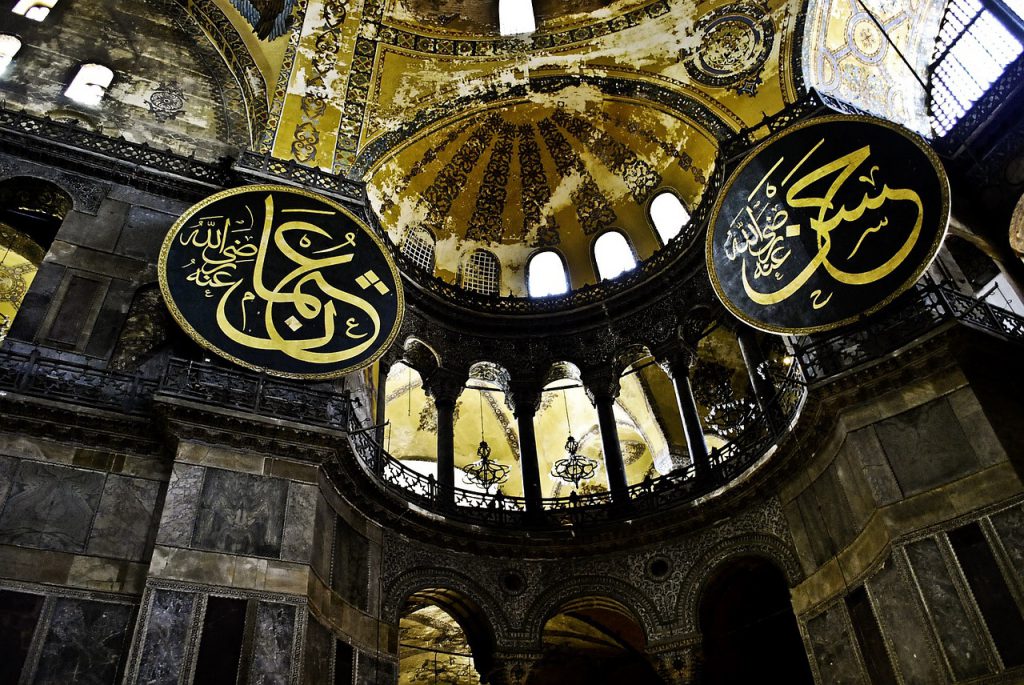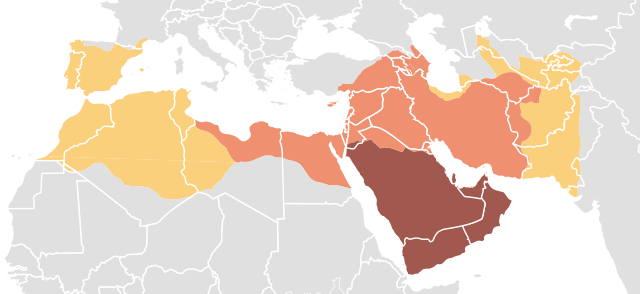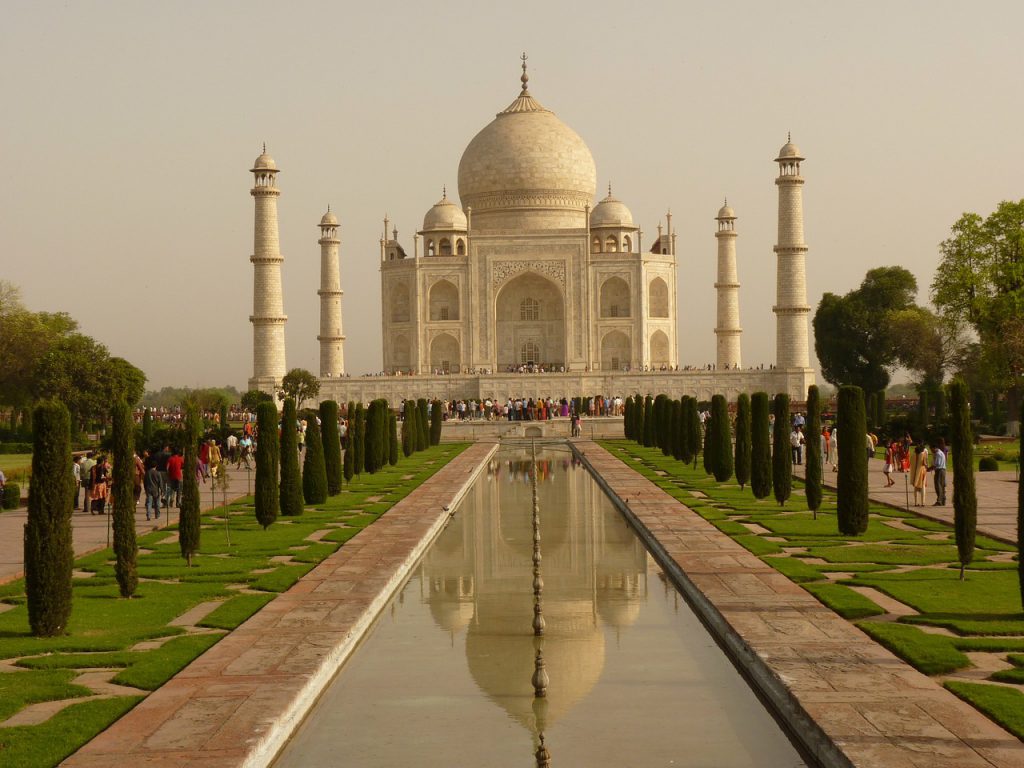Given the widespread popularity of Islam, it is not uncommon to ask what is the history of Islam. Where did it begin? Who started it? How did it grow? What achievements are attributed to Islam? These are just a fraction of the questions that can be asked about the history of Islam due to the rich culture and complexities stemming over a thousand years.
With so many heroes and villains, with tales of epic glory and humiliating defeat, with innovation in all kinds of arts, sciences and architecture, the journey into the history of Islam is absolutely fascinating. However it would be difficult, nigh on impossible, to discuss the entire history of Islam in one article. Indeed you could fill a library of books, and still not have it all presented to you. This post will therefore briefly brush over some of the basics of Islamic history.

The Beginning
Islam is commonly attributed with its beginning around the year 610 AD, when the Prophet Muhammad received the first revelation from the angel Jibreel (Gabriel). Muhammad was 40 years old when this first revelation came. He was meditating as he usually did in a cave in Mount Hira, Mecca when the angel came and stated the first revelation:
“Read… in the name of thy Lord Who made man from a drop of blood… God is Most Rewarding… He Who taught man to write with the pen… and taught man what he knew not.”
More revelations came over the next 23 years, and these were compiled together to form the Quran. During this period, more and more people entered into Islam and became Muslims following what Muhammad was preaching, i.e. that there is only one God.
However, you may find Muslims say that Islam existed well before this period, and that it existed from the very beginning of mankind. This is due to the concept that Islam was not a new religion brought by Muhammad; instead Muhammad was simply a Messenger of God who was sent to humanity to provide a reminder of the existence of one God.
Prior to Muhammad, there were many Messengers sent by God, including Jesus and Moses. The first man, Adam is also considered as a Messenger of God.
Islam, and being a Muslim, simply means believing in and submitting to the will of one God. All of these Prophets preached the idea of one God, and anyone following their message was essentially a believer in one God, and it is in that sense where the idea of Islam starting at the beginning of mankind comes from.
Expansion and Achievement
By the time of Muhammad’s death, Islam had already become popular in the Arabian area. The Caliphate, which is a form of Islamic government, was established after his death, where a successor was chosen to lead the Muslims. The First Caliph was Abu Bakr, who was followed by Umar, who was followed by Uthman, who was followed by Ali. This period lasted from around 632 – 661 AD, and was known as the Rashidun Caliphate.

Pink/Peach – Expansion during the Rashidun Caliphs, 632-661
Yellow – Expansion during the Umayyad Caliphate, 661-750
This period was succeeded by what is now known as the Ummayad Caliphate from around 661 – 750 AD. There were various leaders of the Caliphate, however one thing that was constant was the continuous and rapid expansion of Islam.
Having started in Mecca, Islam now expanded across North Africa, Hispania, Persia, Sindh & Punjab which is now Pakistan. It basically had extended its rule over thee different continents at the same time.
Throughout the following centuries, further Caliphates established themselves, the most famous being the Abbasid Caliphate. This period saw a cultivation of a great intellectual and cultural development in Islam, and in the Middle-East. It was at this time when Baghdad became the intellectual capital of the world with the establishment of the Bayt-ul-Hikmah (the House of Wisdom).
Widely considered as the Golden Age of Islam, it was at this time when astronomical observatories were set up. The House of Wisdom built a reputation for being the greatest centre for the study of science and humanities, ranging from mathematics, astronomy, medicine, alchemy to chemistry amongst other things. The scholars put together a great collection of world knowledge from Greek, Indian, Syriac and Persian sources, and built on it through their own discoveries. The House of Wisdom came to possess the largest selection of books in the world by the ninth century.
Further dynasties, empires and Caliphates came into being throughout the following centuries. Some of the popular ones include the Mughal Empire in what is now Pakistan and India. One of the biggest, and the last, was the Ottoman Empire and Caliphate which ended in 1923.

During these reigns, the Islamic world made major advancements in the fields of science, technology and mathematics. The Islamic world was also responsible for some of the most breath-taking and innovative architecture, ranging from flamboyant palaces to stunning mosques.
Hopefully this article has provided you with a nice introduction as to what is the history of Islam. If you found any part of this article interesting, or have any comments to make, then please do get in touch as we would love to hear from you.
I really like this information that you are giving the public. It is very interesting, and I think crucial, to understand other religions, mainly ones other than your own.
In today’s day and age, I think many people would benefit from reading the information on your website. It may give them a better understand of what is going on in the world.
Thank you very much for your words Jamie. I completely agree about how crucial it is to understand other religions, and even beliefs of people not centred around religion as such. Understanding and communication will be the only way forward for humanity to truly achieve peace.
This is very useful information. We have hundreds of religions in this world. But not many people can break them down and explain like you did here. I’m not Islamic. But this information is very good to know and helps better understand the history of Islam.
I will definnalty share this post on all of my social media sites.
Hey there. Very many thanks for your comment. Really appreciate the words and you sharing the post on your platforms.:-)
Is the last image the Taj Mahal?
If so, what is the link between the Taj Mahal and Islam?
Hi George, thank you for the comment. The image is indeed the Taj Mahal. The Taj Mahal was built by (or commissioned by) the Muslim emperor Shah Jahan at a time when the Mughal Empire was ruling over India. Whilst it contained a mausoleum for his wife, some parts of it was also a mosque (where Muslims pray). It’s also one of the many architectural wonders of the Islamic world, which hopefully will be touched upon in one of the posts soon, God willing.
Really interesting. I’m nor a Muslim but nt brother in law is and my sister embraced that religion. And I always wondered how it all started. My brother in law made me lsisten a short part of a movie that was showing just that. So I knew there that it started like you said a few hundreds of years AD.
Hello Guy, thank you for your comment. I would imagine you have some insightful conversations with your sister and brother in law. If I may ask, how did you feel about the conversion of your sister?
I’m not unfamiliar with this history, I’m sure that the vast knowledge of it is never ending. It is a history that is very important to know. Most of us are taught about the wars waged on the muslims during the crusades. However much of that history is one sided.
Hi,
This was definitely an interesting article to read.
I’ve never really taken the time to explore the origins of Islam so it was nice to get a little more background.
It’s always good to go back and look at the origins of something to see how it all started.
Thanks for providing this information,
Dom